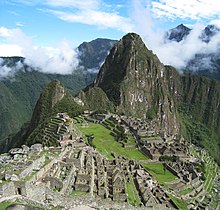Terrace (terrain)
A terrace or terracing (from French terrace ) is a gradation in the terrain .
Natural terraces

Terraces can be created naturally when deeper areas of gently sloping terrain are more susceptible to erosion than higher ones; this creates an embankment and a terrace remains above it. Two forms can be distinguished, the river terrace in the strict sense of the word through direct fluvatile erosion on the valley floor , and the valley shoulder through the following general erosion on the slopes . The transitions are partly fluid (slope shoulders as fossil river terraces), and primarily determined by the physics (hardness and stratification) of the rock. There are also numerous special and local form of training, such as mass movements (both the upper and Versack- Absetzinie as in the outlet) by glacial erosion (addition of Moränenterrassen ) by lava deposition, and numerous other geophysical processes.
The terraces created in this way already offered the possibility in prehistoric times of building relatively flood-proof settlements near rivers or in narrow valleys .

Artificial terraces
Be created artificially terraces to provide lower on slopes surfaces slope, for instance for the terraced fields (terrace culture) or near roads horizontal or gently ascending ramps, if required, also in serpentine guide. In earlier times, terraces were also created for fortifications , and the most important thing was the steep step of the terrace.
Agriculture
Terrace fields
In East Asia, rice is often grown on irrigated terraces. Terraced water storage systems are known from the earliest urban cultures.
Generally there are terraces in mountainous areas when there is farming . Usually walls were built by hand. Particularly noteworthy examples of terrace cultures can be found in Yemen , Nepal , the Iberian Peninsula ( Andalusia ) and the Andes . The Inca Terraces and the Rice Terraces in the Filipino Cordilleras are UNESCO World Heritage Sites .
Today, many terraces are falling into disrepair because the labor-intensive cultivation is too complex and therefore no longer competitive. The Philippine Rice Terraces were inscribed on the Red List of World Heritage in Danger in 2001 .
Viticulture

In viticulture , artificial terraces are often created on suitable, sunlit slopes. Firstly, you gain a less steeply sloping surface for the vineyard, and secondly, soil erosion can be reduced by running rainwater . Were often Terra Siert steep slopes that are not otherwise be farming. Well-known vineyard terraces can be found in many loess areas . In Central and Western Europe, terracing has been reduced or completely removed in many vineyards since the last decades of the 20th century in order to create contiguous areas for machining .
Traffic routes
Terraces laid out as traffic routes are called berms . The construction of roads and railways on mountain slopes increases the risk of erosion. Loads and vibrations of the vehicles can lead to landslides. The steep steps on the terrace can easily be washed out if no measures are taken to secure them. On modern mountain roads such as the Simplonstrasse, for example, rainwater is channeled into a sewer system instead of letting it run off the surface.
Mining

Terraces are also created where open-cast mining is carried out in mountainous terrain . The minerals are removed in the steps and transported on the berms .


